Which language is used for Artificial Intelligence
Depending on the objective, setting, and restrictions, artificial intelligence (AI) development may involve the usage of a variety of programming languages. Several programming languages have been widely employed in the development of AI applications. The language is frequently determined by considerations such as the exact task at hand, the existing ecosystem and libraries available, and the requirements of the development team.
Here are some popular languages used in AI:
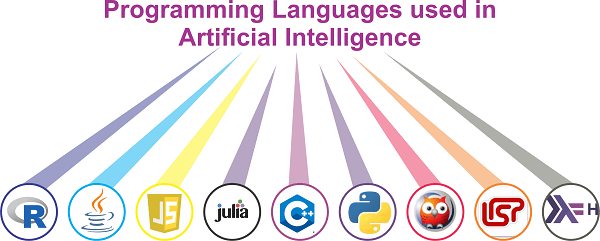
- Python
- R Programming Language
- Java
- C++
- Julia
- Lisp
- Prolog
- JavaScript
- Haskell
Let us learn in detail about these languages
1. Python

With its broad library offerings, straightforward design, and dedicated community support network, Python has become a favored programming language for AI development. Developers can take advantage of the available tools to craft advanced models that suit diverse application scenarios.
Python Libraries that are widely used in AI:
Python has a vast ecosystem of libraries that are widely used in artificial intelligence (AI) development. Here are some popular Python libraries specifically designed for AI tasks:
1.NumPy
2. pandas
3. scikit-learn
4. TensorFlow
5. Keras
6. PyTorch
7. NLTK
8. spaCy
9. OpenCV
- NumPy: NumPy is an essential Python package for scientific computing. It provides efficient numerical operations and multi-dimensional array manipulation, making it essential for data preprocessing and mathematical computations in AI.
- pandas: pandas is a powerful library for data manipulation and analysis. It offers data structures like DataFrames that simplify handling structured data and performing tasks like filtering, aggregation, and transformation, which are essential for AI projects.
- scikit-learn: scikit-learn is like a toolbox of AI algorithms that are ready to use. It provides functions for tasks like classification, regression, and clustering. You can choose and apply these algorithms to solve various AI problems without having to write everything from scratch.
- TensorFlow: TensorFlow plays a crucial role in deep learning model fabrication known for its ability to build effective neural networks that simulate human brain activity enabling developers to tackle complicated problems like image recognition or natural language processing with relative ease.
- Keras: Keras simplifies things further by acting as an intuitive interface layering atop of TensorFlow allowing new developers to AI creation access without difficult coding feats required with other programs.
- PyTorch: PyTorch takes another approach beyond TensorFlow by using dynamic computation graphs creating ample opportunities for researchers wanting more control over experimentation during model development stages.
- NLTK (Natural Language Toolkit): NLTK is like a set of tools specifically designed for working with human language in AI. It helps with tasks like tokenizing words, tagging parts of speech, and analyzing sentiment in text data.
- spaCy: spaCy is a modern NLP library that provides efficient and scalable tools for natural language processing. It focuses on providing fast and accurate tokenization, entity recognition, dependency parsing, and other NLP functionalities.
- OpenCV: OpenCV (Open-Source Computer Vision Library) brings a dynamic range of application in digital image and video processing from feature extraction to object identification fully equipped with robust tools for major computer vision tasks.
These are just a few examples of the many Python libraries available for AI development. The choice of library depends on the specific AI task and requirements of the project.
Key Features of Python that are helpful for AI:
- Simplicity and Readability: Python has a simple and legible syntax, making it simple to learn and create code. This ease of use enables engineers to rapidly prototype AI algorithms, experiment with various techniques, and cooperate productively.
- Large Ecosystem of Libraries: Python offers libraries like NumPy, pandas, scikit-learn, TensorFlow, Keras, and PyTorch providing building blocks already integrated into developing efficient workflows geared towards fast performance capabilities most notably.
- Flexibility and Versatility: One feature that makes Python stand out when it comes to artificial intelligence is its incredible flexibility. Boasting capabilities spanning from data preprocessing & analysis all the way up through machine & deep learning plus even natural language processing; Python is truly versatile. Given this adaptability, developers have a remarkable ability to interchangeably switch between varied AI methodology while avoiding complications along the way.
- Integration and Interoperability: Python integrates well with other programming languages and technologies. It allows developers to combine AI functionalities with existing software systems, databases, web services, APIs, and hardware components. Python's compatibility and support for various interfaces make it easier to integrate AI models into real-world applications.
2. R Programming Language
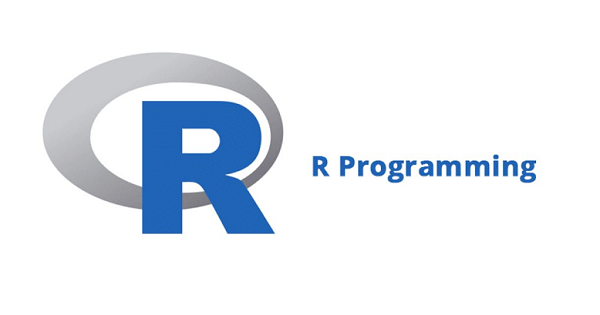
R is a powerful programming language for AI that offers extensive statistical and data manipulation capabilities, machine learning and deep learning libraries, and support for NLP and visualization. Its user-friendly syntax and focus on statistical modeling make it popular among statisticians and data scientists working on AI projects.
Features of the R programming language that are useful for AI:
- Strong statistical capabilities: R provides a wide range of functions and tools for statistical analysis, making it easier to analyze and interpret data in AI applications.
- Large variety of packages: R has a vast collection of packages contributed by the community, offering ready-to-use functions and algorithms for tasks like machine learning, data manipulation, and visualization in AI projects.
- Interactive data exploration: R allows users to interactively explore and visualize data, making it easier to understand patterns and gain insights in AI development.
- Support for reproducible research: R provides tools like R Markdown that enable the integration of code, results, and documentation, ensuring transparency and reproducibility in AI experiments.
- Powerful graphics and visualization: R offer libraries like ggplot2 that allow users to create visually appealing plots and charts, facilitating the communication of AI results and insights effectively.
- Active community support: R has a vibrant community of users who contribute to the development of packages, provide support, and share knowledge, making it easier to learn and get help in AI projects.
- Integration with other languages: R can be easily integrated with other languages like Python, allowing AI practitioners to combine the strengths of different programming languages and libraries for enhanced functionality in AI applications.
R programming language packages that are useful for AI development:
- Caret: Provides a unified interface for machine learning algorithms, enabling easy model building, tuning, and evaluation.
- RandomForest: Implements the powerful random forest algorithm for classification and regression tasks.
- keras: Allows building and training deep neural networks for tasks like image classification and natural language processing.
- e1071: Offers support for support vector machines (SVM) and other statistical learning algorithms commonly used in AI.
- tm: Facilitates text mining and analysis, including tasks like text preprocessing, sentiment analysis, and document-term matrix creation.
- xgboost: Implements the gradient boosting algorithm, useful for boosting ensemble models and achieving high predictive accuracy.
- ggplot2: Provides a versatile and aesthetically pleasing framework for creating customized data visualizations.
- dplyr: Offers efficient data manipulation functions, making it easier to filter, arrange, summarize, and transform data for AI tasks.
- glmnet: Implements elastic net regularization for linear and logistic regression, suitable for high-dimensional data analysis.
- text2vec: Provides tools for text vectorization and analysis, including word embeddings and document-term matrix creation, essential for NLP tasks.
The above-mentioned R packages are important for AI development since they include tools for machine learning, deep learning, data manipulation, text mining, and visualization, allowing for rapid AI model construction and analysis.
3. Java:
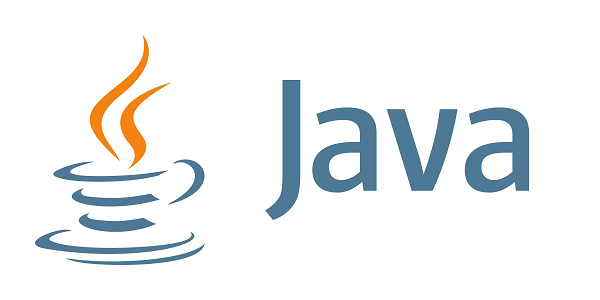
Java is useful for AI development due to its object-oriented nature, platform independence, rich libraries, and strong community support, facilitating the implementation of AI algorithms and applications.
Features of Java programming language that are useful for AI development:
- Platform Independence
- Object-Oriented Programming
- Large Standard Library
- Memory Management
- Multithreading
- Exception Handling
- Networking Capabilities
- Performance and Scalability
- Integration with Existing Systems
- Community Support
Some popular libraries in Java that are useful for AI development:
- Deeplearning4j: Enables distributed training of deep neural networks on big data platforms like Hadoop and Spark, suitable for large-scale AI applications.
- Weka: Provides a comprehensive set of machine learning algorithms and tools for data preprocessing, classification, regression, clustering, and association rule mining.
- DL4J: Offers a flexible deep learning framework for Java, allowing developers to build and train various neural network architectures for AI tasks.
- Encog: Provides neural networks, support for evolutionary algorithms, and advanced data normalization techniques, enabling AI development with emphasis on neural networks.
- Smile: Offers a wide range of machine learning algorithms for classification, regression, clustering, and dimensionality reduction in AI applications.
- TensorFlow Java: Allows integration and execution of TensorFlow models within Java applications, leveraging the power of the popular TensorFlow deep learning framework.
- Mahout: Enables scalable machine learning with algorithms for collaborative filtering, clustering, classification, and recommendation, suitable for big data AI projects.
- Apache OpenNLP: Facilitates natural language processing tasks such as tokenization, named entity recognition, part-of-speech tagging, and more, essential for language-related AI applications.
- Apache Spark MLlib: A distributed machine learning library built on Apache Spark, providing scalable data processing and model building capabilities for AI projects.
- Stanford CoreNLP: Offers a suite of natural language processing tools, including tokenization, sentence parsing, sentiment analysis, and named entity recognition, useful for various AI applications involving text analysis.
4. C++
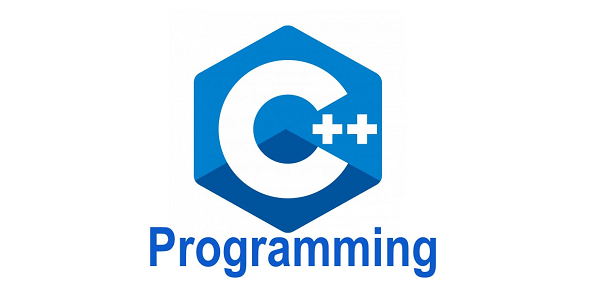
C++ is recognized for its rapidity and effectiveness, making it excellent for high-speed AI applications like computer vision and robotics. It is used to create libraries like OpenCV. Because of its low-level control, broad libraries, and ability to connect with other languages, C++ is useful in AI development, allowing for the high-performance implementation of AI algorithms and systems.
Features of C++ that are useful for AI development:
- Efficiency.
- Low-level control.
- Extensive libraries.
- Object-oriented programming.
- Memory management.
- Support for several paradigms.
- Computing at a high level of performance.
- Interoperability with other languages.
- Scalability.
- Wide industry adoption.
5. Julia

Julia is helpful in AI development due to its high-level syntax and performance. It enables quick code execution, making it suited for computationally heavy AI activities such as machine learning and data processing.
Some features of Julia that are helpful in AI development:
- High-level syntax.
- Multiple dispatch.
- Numerical computing capabilities.
- Parallel computing support.
- Interoperability with other languages.
- Rich ecosystem of packages.
- Easy-to-use data manipulation and visualization.
- Efficient handling of large datasets.
- Fast execution speed.
Few libraries of Julia that are useful for AI development:
- Flux: A flexible deep learning framework in Julia that allows you to build and train neural networks for AI tasks.
- MLJ: A machine learning library in Julia that provides a uniform interface for diverse methods and model assessment.
- TensorFlow.jl: Allows Julia to integrate with TensorFlow, a prominent deep learning framework.
- PyTorch.jl: A Julia interface for PyTorch, a popular deep learning toolkit, allowing for easy integration and usage of PyTorch capabilities.
- Knet: A deep learning library in Julia that supports automatic differentiation and GPU acceleration for neural network training.
- ScikitLearn.jl: A Julia wrapper for scikit-learn, a comprehensive machine learning library in Python, enabling access to scikit-learn's functionality within Julia.
- Gen: A probabilistic programming library that allows users to specify and work with generative models in Julia.
- Mocha: A deep learning framework that offers efficient GPU support and a high-level interface for building neural networks in Julia.
- JuMP: A modeling language and optimization library that enables easy formulation and solving of optimization problems in Julia.
- DataFrames.jl: A library for working with tabular data, providing tools for data manipulation, filtering, and analysis in Julia.
6. Lisp

Lisp is helpful in AI development due to its flexible and expressive nature, allowing for the easy manipulation of symbolic data and the development of sophisticated algorithms.
Some features of Lisp that are helpful in AI development:
- Dynamic and interactive programming.
- Powerful macro system.
- Symbolic data manipulation.
- Automatic memory management.
- Extensibility and metaprogramming capabilities.
- Higher-order functions and closures.
- Interactive development environment.
- Support for functional programming paradigms.
- Easy integration with other programming languages.
- Lisp's long-standing history and usage in AI research.
Few libraries of Lisp that are useful for AI development:
- CL-GSL: Provides access to the GNU Scientific Library, enabling Common Lisp programmers to utilize a wide range of mathematical and scientific functions.
- Alexandria: Offers a collection of utility functions for Common Lisp, providing convenience and efficiency in AI development tasks.
- Bordeaux-Threads: Facilitates concurrent and parallel programming in Common Lisp, allowing for efficient execution of AI algorithms that benefit from parallelism.
- CFFI: Enables interaction with C code from Common Lisp, providing a way to leverage existing C libraries and integrate them into AI projects.
- CL-MathStats: Provides statistical functions and algorithms for data analysis and modeling, supporting AI applications that require statistical analysis.
- Parenscript: Allows writing JavaScript code using a Lisp-like syntax within Common Lisp, aiding in the development of web-based AI applications.
- Eazy-Gnuplot: Simplifies the generation of graphs and plots using Gnuplot from Common Lisp, aiding in data visualization tasks in AI projects.
- FSet: Offers a functional set manipulation library for Common Lisp, providing convenient operations on sets for tasks like data filtering and manipulation.
- Portable-ASDF: Facilitates project management and system definition in Common Lisp, ensuring portability and ease of deployment for AI applications.
- LTK: Provides a lightweight toolkit for creating graphical user interfaces (GUIs) in Common Lisp, allowing for the development of interactive AI applications.
7. Prolog:
Prolog is helpful in AI development due to its logical and declarative nature, making it suitable for tasks such as rule-based reasoning, knowledge representation, and expert systems.
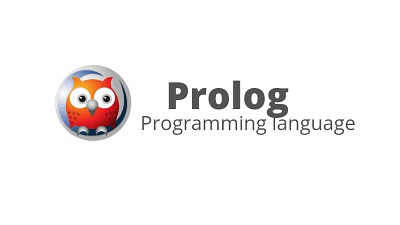
Some features of Prolog that are helpful in AI development:
- Logical programming paradigm.
- Rule-based reasoning.
- Backtracking and search capabilities.
- Pattern matching and unification.
- Built-in support for symbolic computation.
- Extensibility through user-defined predicates.
- Efficient handling of the complex symbolic data.
- Natural language processing capabilities.
- Declarative and expressive syntax.
Few libraries of Prolog that are useful for AI development:
- SWI-Prolog: Offers a wide range of tools and libraries for AI development, including modules for natural language processing, constraint programming, and data manipulation.
- Amzi! Prolog: Provides various libraries and development tools for building intelligent applications, including modules for expert systems, knowledge representation, and rule-based reasoning.
- YAP Prolog: Efficiently handles constraint programming and finite domain solving, enabling the development of AI applications that require constraint-based problem-solving.
- GNU Prolog: Equipped with libraries for constraint logic programming and combinatorial optimization, aiding in the development of AI systems that require constraint solving and optimization.
- SICStus Prolog: Offers libraries for constraint solving, natural language processing, and constraint-based graphics, providing support for various AI tasks such as constraint-based modeling and language processing.
- XSB Prolog: Supports tabling and indexing, enabling efficient execution of recursive queries, which is beneficial for AI applications that involve complex computations and recursive logic.
- Ciao Prolog: Provides libraries for constraint logic programming, theorem proving, and distributed computing, facilitating the development of AI systems with advanced logical reasoning capabilities.
- B-Prolog: Equipped with libraries for constraint logic programming, logic-based machine learning, and probabilistic reasoning, enabling the development of AI systems that require advanced logical and probabilistic modeling.
- ECLiPSe Prolog: Offers libraries for constraint programming, optimization, and combinatorial search, supporting AI applications that involve complex constraint-based problem-solving and optimization tasks.
8. JavaScript

JavaScript is useful in AI development because it is widely used in web-based applications, allowing for the implementation of AI algorithms in a web browser. real-time interactions, and connection with other online technologies.
Some features of JavaScript that are helpful in AI development:
- Popular usage
- Integration with websites
- Real-time interactions
- Data handling
- Efficient programming
- Visual representation
- Machine learning support
- Active developer community
- Mobile app development capability
- Versatile application possibilities
Few libraries of JavaScript that are useful for AI development:
- Brain.js: A flexible library for building neural networks and implementing machine learning algorithms in JavaScript.
- Synaptic.js: A lightweight neural network library that provides tools for training and implementing various AI algorithms in JavaScript.
- ConvnetJS: Specifically designed for deep learning, ConvnetJS offers neural network modeling and training capabilities in JavaScript.
- ML5.js: Simplifies machine learning tasks by providing pre-trained models and tools for using machine learning in creative applications.
- Neataptic: A modular neural network library that supports deep learning and evolutionary algorithms in JavaScript.
- WebDNN: Enables the deployment of deep learning models on the web, optimizing their execution for performance and efficiency.
- Compromise: A natural language processing library that simplifies the extraction of information and analysis of text data in JavaScript.
9. Haskell

Haskell is helpful in AI development due to its strong type system, purity, and functional programming features, which enable robust and efficient algorithm design and implementation.
Some features of Haskell that are helpful in AI development:
- Strong type system
- Functional programming
- Pattern matching
- Type inference
- Higher-order functions
- Concurrency and parallelism
- Advanced type system features
- Interoperability
Conclusion:
To conclude, numerous programming languages are employed in AI development, and they possess unique advantages and uses. Python is commonly recognized as a leading language in artificial intelligence due to its huge libraries, simplicity, and adaptability.
R is another popular language, particularly known for its strong statistical capabilities. It provides numerous libraries and packages, such as caret, randomForest, and e1071, which are specifically tailored for data analysis and statistical modeling in AI.
Java and C++ are recognized for their performance and efficiency, making them suitable for AI applications that require computational speed and resource optimization. Libraries like DL4J (DeepLearning4J) and DeeplearningCPP provide support for deep learning in these languages.
Other languages such as Julia, Lisp, Prolog, Haskell, and JavaScript also have their place in AI development, offering unique features and libraries for specific AI tasks.
Overall, the language of choice is determined by the unique needs, ecosystem support, and development team familiarity, assuring the correct toolset for creating efficient and creative AI solutions. Whatever language is employed, the ultimate objective is to apply AI techniques and algorithms to solve complicated problems, assess data, and make informed decisions. The AI domain is still growing, and these languages are critical to increasing growth and success in this field.